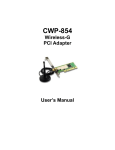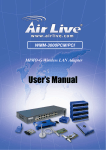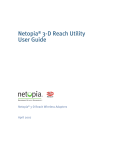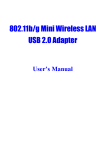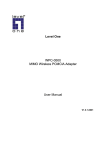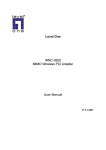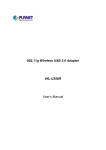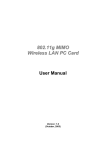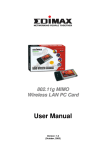Download CUA-854
Transcript
CUA-854 Wireless-G Long Range USB Adapter with Antenna User’s Guide Table of Contents Chapter 1. Introduction....................................................................................5 1.1. 1.2. 1.3. About CUA-854 ......................................................................................................5 Key Features ..........................................................................................................5 Package Included ...................................................................................................5 Chapter 2. Chapter 3. Connect your antenna...................................................................6 Installing Driver, Configuration Utility and Hardware.................7 3.1. 3.2. Driver Installation for Windows 98SE/ME/2000/2003/XP.......................................7 Driver Installation for Windows Vista ................................................................... 10 Chapter 4. Using the Configuration Utility for 98SE/ME/2000/2003/XP .....14 4.1. 4.2. 4.3. 4.3.1. 4.3.2. 4.3.3. 4.3.4. 4.3.5. 4.3.6. Overview.............................................................................................................. 14 Access the Configuration Utility........................................................................... 14 Getting to Know the Utility ................................................................................... 16 Profile.................................................................................................................. 16 Link Status ......................................................................................................... 27 Site Survey ......................................................................................................... 28 Statistics ............................................................................................................. 30 Advanced............................................................................................................ 31 About .................................................................................................................. 33 Chapter 5. Troubleshooting ..........................................................................34 2 List of Figures Figure 2-1 connect antenna with SMA connector .......................................................................6 Figure 3-1 AutoPlay Menu..............................................................................................................7 Figure 3-2 Setup: License Agreement ..........................................................................................7 Figure 3-3 Setup: Choose Configuration TxBurst or WiFi .........................................................8 Figure 3-4 Setup: Setup Status .....................................................................................................8 Figure 3-5 Setup: plug-in message...............................................................................................9 Figure 3-6 Setup: Click Finish to Complete (for WIN2000 / 2003 / XP)......................................9 Figure 3-7 Setup: Click Finish to Complete (for WIN98 / ME) ................................................. 10 Figure 3-8 AutoPlay Confirm Window (Vista) ........................................................................... 10 Figure 3-9 AutoPlay Menu (Vista)................................................................................................11 Figure 3-10 Setup: License Agreement (Vista) ..........................................................................11 Figure 3-11 Setup: Setup Status (Vista)..................................................................................... 12 Figure 3-12 Setup: plug-in message (Vista).............................................................................. 12 Figure 3-13 Setup: Found New Hardware (Vista) ..................................................................... 13 Figure 3-14 Setup: Click Finish to Complete (Vista) ................................................................ 13 Figure 4-1 Utility Icon .................................................................................................................. 14 Figure 4-2 Wireless Zero Configuration: Select Manage......................................................... 14 Figure 4-3 Wireless Zero Configuration: Select Wireless Zero Configuration...................... 15 Figure 4-4 Wireless Zero Configuration: Select Disable ......................................................... 15 Figure 4-5 Utility – Profile ........................................................................................................... 16 Figure 4-6 Add Profile: Configuration ....................................................................................... 18 Figure 4-7 Add Profile: Authentication and Security: Open or Shared Key .......................... 20 Figure 4-8 Add Profile: Authentication and Security: LEAP ................................................... 22 Figure 4-9 Add Profile: Authentication and Security: WPA/ WPA-PSK/ WPA2/ WPA-PSK ... 23 Figure 4-10 Add Profile: Authentication and Security: 802.1x Setting: Certification ........... 24 Figure 4-11 Add Profile: Authentication and Security: 802.1x Setting: CA Server ............... 26 Figure 4-12 Utility - Link Status .................................................................................................. 27 Figure 4-13 Utility – Site Survey................................................................................................. 28 Figure 4-14 Utility – Statistics..................................................................................................... 30 Figure 4-15 Utility – Advanced ................................................................................................... 31 Figure 4-16 Utility - Link About................................................................................................... 33 3 List of Figures Table 4-1 Profile ........................................................................................................................... 17 Table 4-2 Configuration............................................................................................................... 19 Table 4-3 Authentication: Open or Shared ................................................................................ 21 Table 4-4 Authentication: LEAP ................................................................................................. 22 Table 4-5 Authentication: WPA/ WPA-PSK/ WPA2/ WPA-PSK ................................................. 23 Table 4-6 Authentication: 802.1x Setting: Ceritication............................................................. 25 Table 4-7 Authentication: 802.1x Setting: CA Server ............................................................... 26 Table 4-8 Link Status ................................................................................................................... 27 Table 4-9 Site Survey................................................................................................................... 29 Table 4-10 Statistics..................................................................................................................... 30 Table 4-11 Advanced.................................................................................................................... 32 4 Chapter 1. Introduction 1.1. About CUA-854 The CUA-854 is a wireless-G long range USB adapter which offers you a removable antenna with SMA connector which can connect with any long range antenna you prefer. With a magnetic base, it helps you easily to stick it on the metal wall and extend your network coverage significantly. Once installed and connected, you can keep in touch with friends and work through e-mail, instant messaging and chat rooms as well as sharing files and other network resources such as printers and network storage with other computers. The CUA-854 follows IEEE 802.11g wireless standard works at the speed of 54Mbps and for added versatility; it also interoperates with all Wireless-B (IEEE 802.11b) products found at homes, businesses, and public wireless hotspots around the country. 1.2. Key Features The following lists the main features of the Wireless-G USB Adapter. • 5 Times Faster and seamless operation with existing Wireless-B networks. • 64/128-bit WEP and WPA/WPA2 (Wi-Fi Protected Access) Encryption Provides Maximum Wireless Security. • Compatible with Windows 98SE/ME/2000/2003/XP/Vista. • User can change antennas according to their demand by connecting the antenna with the SMA connector. • The CUA-854 is with a magnet base which can be stick. 1.3. • • • Package Included CUA-854 with 5 dBi or 7 dBi antenna CD with driver, utility and User’s Guide The QIG 5 Chapter 2. Connect your antenna Figure 2-1 connect antenna with SMA connector 6 Chapter 3. Installing Driver, Configuration Utility and Hardware 3.1. Driver Installation for Windows 98SE/ME/2000/2003/XP Before installing your long range Wireless-G USB Adapter, insert the Auto-Install CD into your CD-ROM drive. Unless you have disabled the auto-run feature of Windows, the AutoPlay Menu should appear automatically. If not, you can manually access the installation by clicking the Start button and choosing Run. In the drop-down box type D:\ AUTORUN.EXE (where D: is the drive letter for your CD-ROM drive). Alternately, double-click My Computer and double-click on the CD drive icon. - Click on CUA-854 to install driver/utility for your Long Range Wireless-G USB Adapter. Figure 3-1 AutoPlay Menu - After reading through the License Agreement, please click Yes to continue. Figure 3-2 Setup: License Agreement - Choose the Optimize for performance mode and click Next, you will get 7 better performance. It will enable the Tx BURST and TCP Window Size feature in the utility. Figure 3-3 Setup: Choose Configuration TxBurst or WiFi Figure 3-4 Setup: Setup Status - During the installation, there will pops up a plug-in message screen. Please insert the Wireless-G USB Adapter into the USB port at this moment. Figure 3-5 Setup: plug-in message 8 - In Windows XP and 2000, click Finish to complete the installation. Figure 3-6 Setup: Click Finish to Complete (for WIN2000 / 2003 / XP) - In Windows 98SE and ME, please select Yes, I want to restart my computer now and click Finish to complete the installation. The system will restart automatically. 9 Figure 3-7 Setup: Click Finish to Complete (for WIN98 / ME) Note: In Windows ME and 98SE, after the installation is completed, Windows will ask to restart the computer, just click Yes to restart. 3.2. Driver Installation for Windows Vista Before installing your Long Range Wireless-G USB Adapter, insert the Auto-Install CD into your CD-ROM drive. - There will be a Vista AutoPlay Confirm Window. Click Run AUTORUN.EXE icon. Figure 3-8 AutoPlay Confirm Window (Vista) - Click on CUA-854 to install driver/utility for your Wireless-G USB Adapter. Figure 3-9 AutoPlay Menu (Vista) 10 - After reading through the License Agreement, please click Yes to continue. Figure 3-10 Setup: License Agreement (Vista) - The driver will be installed to your computer. The Setup Status screen will be displayed. Figure 3-11 Setup: Setup Status (Vista) 11 - There will be a plug-in message screen. Please insert the Wireless-G USB Adapter into the USB port now. Figure 3-12 Setup: plug-in message (Vista) - Click Ask me again later when the Found New Hardware window appears. Figure 3-13 Setup: Found New Hardware (Vista) 12 - Click Finish to complete the installation. Figure 3-14 Setup: Click Finish to Complete (Vista) 13 Chapter 4. Using the Configuration Utility for 98SE/ME/2000/2003/XP 4.1. Overview The wireless Configuration Utility can be used to check link information, search for available wireless networks, or to create profiles that hold different configuration settings. 4.2. Access the Configuration Utility The Configuration Utility icon will appear in your system tray. Double-click the icon. Figure 4-1 Utility Icon The utility contains six parts: Profile, Link Status, Site Survey, Statistics, Advance, and About. You should change all your configuration settings for the Wireless-G USB Adapter by using this utility. Note: In Windows XP, you should disable the Wireless Zero Configuration service following the steps below: A. Right Click My Computer on the desktop and select Manage. Figure 4-2 Wireless Zero Configuration: Select Manage 14 B. The Computer Management window comes up. Select Services from the Services and Applications menu. Scroll down to locate Wireless Zero Configuration service. Figure 4-3 Wireless Zero Configuration: Select Wireless Zero Configuration C. Double Click on Wireless Zero Configuration to go into its properties. For Startup type, choose Disable to disable the Wireless Zero Configuration then click Apply and OK to make the changes effective. Now you can use our Configuration Utility instead of Windows XP Wireless Zero Configuration Utility. Figure 4-4 Wireless Zero Configuration: Select Disable 15 4.3. Getting to Know the Utility 4.3.1. Profile The Profile can keep your favorite wireless settings among your home, office and other public hotspots. You may save multiple profiles and activate the correct one at your preference. Figure 4-5 Utility – Profile 16 Table 4-1 Profile L ABEL DESCRIPTION Profile Name Connection profile name. There is a connection icon standing for the connection status, : Indicate connection is successful on currently activated profile. : Indicate connection fails on currently activated profile. SSID Wireless station or ad-hoc name. Channel Channel in use for this wireless connection. Authentication The Authentication method used for this profile. Encryption The Encryption type used for this profile. Network Type The Network type used for this profile. Add Click Add to create a new profile. Delete Click Delete to delete a selected profile. Edit Select a profile, and click Edit to change an existing profile. Activate To activate a specific profile, select the profile, and click Activate button. OK To pop-down this utility menu. Help Click Help to display on-line help information in a pop-up screen. 17 4.3.1.1. Create a New Profile Click the Add button on the Profile screen to create a new profile. (A) Add Profile: Configuration Fill the Profile Name and SSID for this new profile. Figure 4-6 Add Profile: Configuration 18 Table 4-2 Configuration L ABEL DESCRIPTION Profile Name Enter the profile name that you want. SSID User can key in the intended SSID name or use pull down menu to select from available wireless network. PSM CAM (Constantly Awake Mode) – the wireless Adapter will stay full power when AC power cord is plugged into power outlet. PSM (Power Saving Mode) – the wireless Adapter will enter the power saving mode. Network Type There are two wireless modes. (A) Infrastructure - This mode allows wireless and wired networks to communicate through an access point. (B) Ad-hoc - This mode allows wireless-equipped computers to communicate directly with each other. Preamble There are three types: Auto, Long and Short are supported. Ad-hoc wireless mode There are three types: 802.11B only, 802.11B/G mixed and 802.11G only modes are supported. TX Power Transmit power, the amount of power used by a radio transceiver to send the signal out. User can choose power value by sliding the bar. RTS Threshold User can adjust the RTS threshold number by sliding the bar or key in the value directly. The default value is 2347. Fragment Threshold User can adjust the Fragment Threshold number by sliding the bar or key in the value directly. The default value is 2346. Channel Only available for setting under ad-hoc mode. User can choose the channel frequency to start their ad-hoc network. OK Confirms and saves the settings. Cancel Ignore the settings and return to the previous screen. Help Click Help to display on-line help information in a pop-up screen. 19 (B) Add Profile: Authentication and Security Enter the authentication and security information here. Figure 4-7 Add Profile: Authentication and Security: Open or Shared Key 20 Table 4-3 Authentication: Open or Shared L ABEL DESCRIPTION Authentication Type Under Open System authentication, any wireless station can request authentication. Under Shared Key authentication, each wireless station is assumed to have received a secret shared key over a secure channel that is independent from the 802.11 wireless network communications channel. To use Shared Key authentication, you must have a network key. Encryption Select None or WEP WEP Key#1 .. 4 When select the WEP encryption or Shared Key authentication without 802.1x, you should enter the WEP key correctly. If the WEP key is 64-bit, please enter 10 hexadecimal or 5 ASCII characters. If the WEP key is 128-bit, please enter 26 hexadecimal or 13 ASCII characters. Show Password When you check this function, the password will not be covered by * symbol. Use 802.1x Select this option to enable IEEE 802.1x for user authentication. IEEE 802.1x can support true authentication and user control 802.1x setting When enabling IEEE 802.1x, you should set the IEEE 802.1x parameters. 21 Figure 4-8 Add Profile: Authentication and Security: LEAP Table 4-4 Authentication: LEAP L ABEL DESCRIPTION Authentication Type Identity Light Extensible Authentication Protocol. It is an EAP authentication type used primarily in Cisco Aironet WLANs. It encrypts data transmissions using dynamically generated WEP keys, and supports mutual authentication. Enter identity for the LEAP authentication service Password Enter password for the LEAP authentication service. Show Password When you check this function, the password will not be covered by * symbol. 22 Figure 4-9 Add Profile: Authentication and Security: WPA/ WPA-PSK/ WPA2/ WPA-PSK Table 4-5 Authentication: WPA/ WPA-PSK/ WPA2/ WPA-PSK L ABEL DESCRIPTION Authentication Type Select WPA, WPA-PSK, WPA2 or WPA-PSK Encryption Specify an encryption method to use. Select TKIP (Temporal Key Integrity Protocol) that uses a stronger encryption algorithm and protects against hackers with MIC (Message Integrity Check). Select AES (Advanced Encryption System) that uses symmetric 128-bit block data encryption. WPA-PSK Enter WPA Preshared Key, only valid for WPA-PSK and WPA2-PSK. This key should be between 8 and 32 characters in length. 802.1x setting Only valid for WPA and WPA2. Show Password When you check this function, the password will not be covered by * symbol. 23 (C) Add Profile: 802.1x IEEE 802.1x supports true authentication and user control. Figure 4-10 Add Profile: Authentication and Security: 802.1x Setting: Certification 24 Table 4-6 Authentication: 802.1x Setting: Ceritication L ABEL DESCRIPTION Authentication Type PEAP: Protected Extensible Authentication Protocol. PEAP transports authentication data by using tunneling between PEAP clients and an authentication server. PEAP can authenticate wireless LAN clients using only server-side certificates, thus simplifying the implementation and administration of a secure wireless LAN. TLS/Smart Card: Transport Layer Security, provides with certificate-based and mutual authentication of the client and the network. It relies on client-side and server-side certificates to perform authentication and can be used to dynamically generate user-based and session-based WEP keys to secure subsequent communications between the WLAN client and the access point. TTLS: Tunneled Transport Layer Security, this security method provides for certificate-based, mutual authentication of the client and network through an encrypted channel. Unlike EAP-TLS, EAP-TTLS requires only server-side certificates. Session Resumption MD5-Challenge: Message Digest Challenge, is an EAP authentication type that provides base-level EAP support. It only supports one-way authentication i.e. there is no mutual authentication of wireless client and the network. It’s only valid for profile’s authentication type to be none or shared. User can choose Disabled, Reauthenticate, Roaming, SameSsid or Always. Identity Enter the Identity for server Password Enter the Password for server Use Client Certificate Enable the client certificate for server authentication. Tunnel Authentication Protocol Tunnel protocol, List information includes EAP-MSCHAP, EAP-MSCHAP v2, CAHAP and MD5. Identity Enter Identity for tunnel Password Enter Password for tunnel If you want to use CA server, please click CA Server page. Depending on the EAP in use, only the server or both the server and client may be authenticated and require a certificate. Server certificates identify a server, usually an authentication or RADIUS server to clients. Most EAPs require a certificate issued by a root authority or a trusted commercial CA. 25 Figure 4-11 Add Profile: Authentication and Security: 802.1x Setting: CA Server Table 4-7 Authentication: 802.1x Setting: CA Server L ABEL DESCRIPTION Use certificate chain Enable the certificate feature Certificate issuer Choose to use server that is the issuer of certificates. Allow intermidiate certificates It must be in the server certificate chain between the server certificate and the server specified in the certificate issuer field. Server name Enter the authentication server’s name. There are two matching methods, - Server name must match exactly. - Domain name must end in specified name. 26 4.3.2. Link Status The Link Status provides the link information of the Wireless-G USB Adapter with Atenna. Figure 4-12 Utility - Link Status Table 4-8 Link Status L ABEL DESCRIPTION Status Displays current connection status. If no connection, it will show Disconnected. Otherwise, the SSID and BSSID will show here. Displays link status and current channel in use. Extra Info Channel Link Speed Throughput Link Quality Signal Strength Noise Level Shows the channel which the wireless network devices are currently using. Tx(Mbps) field shows the transfer rate in megabits per second. Rx(Mbps) field shows the receive rate in megabits per second. Shows the amount of data moved successfully form one place to another in a given time period. The level of Link Quality is displayed here by a bar indicating percentage, between 0 and 100 percent. The level of Signal Strength is displayed here by a bar indicating percentage, between 0 and 100 percent. The Noise Level is displayed here by a bar indicating percentage, between 0 and 100 percent. 27 4.3.3. Site Survey The site survey page displays a list of all Infrastructure and Ad-hoc wireless networks available for connection. Figure 4-13 Utility – Site Survey 28 Table 4-9 Site Survey L ABEL DESCRIPTION SSID Service Set ID of the Wireless Network. BSSID Basic Service Set ID of the Wireless Network. Signal Signal Strength status. Channel The channel used by Wireless Network. Encryption Encryption type. Authentication Authentication type used. Network Type Wireless Network mode. (Infrastructure mode or Ad-hoc mode) Rescan Click Rescan to re-search for wireless networks. Connect Select one of the networks on the list, and click the Connect button. Please note that if the wireless network has encryption enabled, you can’t connect. If you want to connect, you must add a profile in the Profile Tab. Note: There is no Connect button in Window Vista. You have to use the Add Profile feature to build the wireless connection with the selected network. Please refer to the Profile information. Add the selected network to Profile List. Add Profile 29 4.3.4. Statistics The Statistics screen provides information about the Transmit and Receive Statistics. You can reset counters if you need, otherwise click OK. Figure 4-14 Utility – Statistics Table 4-10 Statistics L ABEL DESCRIPTION Transmit Statistics Displays current transmit frame information Receive Statistics Displays current receive frame information. Reset Counter Resets all counter to zero. 30 4.3.5. Advanced The Advanced screen shows settings for Wireless Mode, Ad-hoc wireless mode, TX BURST, B/G Protection, Tx Rate and RF On/Off. Figure 4-15 Utility – Advanced 31 Table 4-11 Advanced L ABEL DESCRIPTION Wireless mode Tx Rate 802.11 B only: allows to connect to the 802.11b wireless stations only. 802.11 B/G mix: allows to connect to the 802.11b or 802.11g wireless stations. When the network type is in Ad Hoc mode that the wireless adapter can only work in 802.11b data rate. It is defined by Wi-Fi organization. If you want to enable the data rate up to 54Mbps, please select Ad-hoc wireless mode. If there are 802.11b and 802.11g wireless stations in the network, it is recommended to enable the B/G Protection mechanism. Auto: Based on the status of the network and automatically disable/enable protection mode. On: Always send frame with protection. Off: Always send frame without protection. Manually selected the transmit rate. Default is auto. Tx Burst A proprietary frame burst mode which can improve transmission speed. Enable TCP Window Size Enables the TCP Window Size to improve the TCP performance over wireless link. Fast Roaming Roaming mechanism setup by transmit power. Roaming will be happened if the station power is less than the defined power. Selects the correct region code for your country. Ad-hoc wireless mode B/G Protection Select Your Country Region Code CCX2.0 Turn off RF/ Turn on RF Apply Supports Cisco Compatible Extensions functions: 1. LEAP turn on CCKM 2. Enable Radio Measurement: Channel measurement every 0~2000 milliseconds. You can turn off or turn on the RF feature. Save the changes. 32 4.3.6. About The About screen shows release dates as well as driver/utility versions and the MAC/IP address of the wireless adapter. Figure 4-16 Utility - Link About 33 Chapter 5. Troubleshooting 1. I cannot connect to the configuration utility. • • Make sure the wireless adapter is inserted properly. Make sure you have installed the correct driver and utility version for your wireless adapter. 2. I cannot connect to a wireless network. • • • Make sure the wireless router or AP is within range. Move your computer closer to the wireless router. Make sure that you have set the wireless network settings correctly. For example, the SSID and security settings. Make sure there is no radio interference (for example, cordless phones, microwave oven, etc) that may affect wireless transmission quality. 34


































